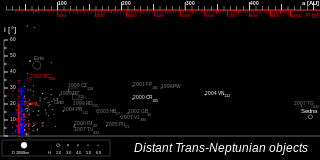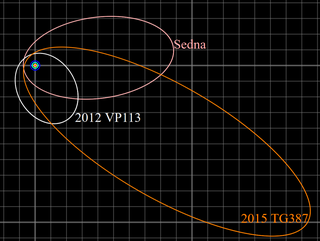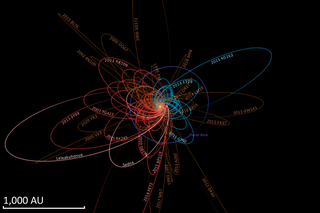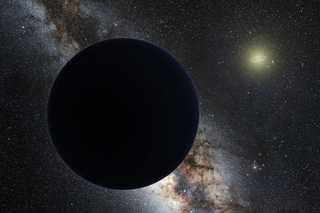Planet X may refer to:
Planet X may refer to:
Nemesis is a Greek mythological spirit of divine retribution against those who succumb to hubris. Nemesis may also refer to:

Following the discovery of the planet Neptune in 1846, there was considerable speculation that another planet might exist beyond its orbit. The search began in the mid-19th century and continued at the start of the 20th with Percival Lowell's quest for Planet X. Lowell proposed the Planet X hypothesis to explain apparent discrepancies in the orbits of the giant planets, particularly Uranus and Neptune, speculating that the gravity of a large unseen ninth planet could have perturbed Uranus enough to account for the irregularities.
A rogue is a person or entity that flouts accepted norms of behavior or strikes out on an independent and possibly destructive path.
A trans-Neptunian object (TNO), also written transneptunian object, is any minor planet in the Solar System that orbits the Sun at a greater average distance than Neptune, which has an orbital semi-major axis of 30.1 astronomical units (au).
Genesis may refer to:

Sedna is a dwarf planet in the outermost reaches of the Solar System, orbiting the Sun beyond the orbit of Neptune. Discovered in 2003, the planetoid's surface is one of the reddest known among Solar System bodies. Spectroscopy has revealed Sedna's surface to be mostly a mixture of the solid ices of water, methane, and nitrogen, along with widespread deposits of reddish-colored tholins, a chemical makeup similar to those of some other trans-Neptunian objects. Within the range of uncertainties, it is tied with the dwarf planet Ceres in the asteroid belt as the largest dwarf planet not known to have a moon. Its diameter is roughly 1,000 km. Owing to its lack of known moons, the Keplerian laws of planetary motion cannot be employed for determining its mass, and the precise figure as yet remains unknown.

Derek Sherinian is an American keyboardist of Armenian descent who has toured and recorded for Alice Cooper, Billy Idol, and Joe Bonamassa, among others. He was also a member of Dream Theater from 1994 to 1999, is the founder of Planet X and also one of the founding members of Black Country Communion, Sons of Apollo, and Whom Gods Destroy. He has released nine solo albums that have featured a variety of prominent guest musicians, including guitarists Slash, Yngwie Malmsteen, Allan Holdsworth, Steve Lukather, Joe Bonamassa, Michael Schenker, Steve Vai and Al Di Meola, and extensively drummer Simon Phillips.
A vortex is a dynamic phenomenon of fluids.
A demon is a malevolent supernatural being in religion, occultism, mythology, folklore, and fiction.
Inertia is the resistance of a physical object to change in its velocity.
Star seed or starseed may refer to:
Vulcan may refer to:

Detached objects are a dynamical class of minor planets in the outer reaches of the Solar System and belong to the broader family of trans-Neptunian objects (TNOs). These objects have orbits whose points of closest approach to the Sun (perihelion) are sufficiently distant from the gravitational influence of Neptune that they are only moderately affected by Neptune and the other known planets: This makes them appear to be "detached" from the rest of the Solar System, except for their attraction to the Sun.

The following outline is provided as an overview of and topical guide to the Solar System:

2012 VP113, also known by its nickname "Biden", is a trans-Neptunian object of the sednoid population, located in the outermost reaches of the Solar System. It was first observed on 5 November 2012 by American astronomers Scott Sheppard and Chad Trujillo at the Cerro Tololo Inter-American Observatory in Chile. The discovery was announced on 26 March 2014. The object probably measures somewhere between 300 and 1000 km in diameter, possibly large enough to be a dwarf planet.

A sednoid is a trans-Neptunian object with a perihelion well beyond the Kuiper cliff at 47.8 AU. The consensus among astronomers is that there are only three objects that are known from this population: 90377 Sedna, 2012 VP113, and 541132 Leleākūhonua (2015 TG387). All three have perihelia greater than 60 AU. These objects lie outside an apparently nearly empty gap in the Solar System and have no significant interaction with the planets. They are usually grouped with the detached objects. Some astronomers consider the sednoids to be inner Oort cloud objects (OCOs), though the inner Oort cloud, or Hills cloud, was originally predicted to lie beyond 2,000 AU, beyond the aphelia of the three known sednoids.

An extreme trans-Neptunian object (ETNO) is a trans-Neptunian object orbiting the Sun well beyond Neptune (30 AU) in the outermost region of the Solar System. An ETNO has a large semi-major axis of at least 150–250 AU. The orbits of ETNOs are much less affected by the known giant planets than all other known trans-Neptunian objects. They may, however, be influenced by gravitational interactions with a hypothetical Planet Nine, shepherding these objects into similar types of orbits. The known ETNOs exhibit a highly statistically significant asymmetry between the distributions of object pairs with small ascending and descending nodal distances that might be indicative of a response to external perturbations.

Planet Nine is a hypothetical ninth planet in the outer region of the Solar System. Its gravitational effects could explain the peculiar clustering of orbits for a group of extreme trans-Neptunian objects (ETNOs), bodies beyond Neptune that orbit the Sun at distances averaging more than 250 times that of the Earth. These ETNOs tend to make their closest approaches to the Sun in one sector, and their orbits are similarly tilted. These alignments suggest that an undiscovered planet may be shepherding the orbits of the most distant known Solar System objects. Nonetheless, some astronomers question this conclusion and instead assert that the clustering of the ETNOs' orbits is due to observational biases, resulting from the difficulty of discovering and tracking these objects during much of the year.

541132 Leleākūhonua (provisional designation 2015 TG387) is an extreme trans-Neptunian object and sednoid in the outermost part of the Solar System. It was first observed on 13 October 2015, by astronomers at the Mauna Kea Observatories, Hawaii. Based on its discovery date near Halloween and the letters in its provisional designation 2015 TG387, the object was informally nicknamed "The Goblin" by its discoverers and later named Leleākūhonua, comparing its orbit to the flight of the Pacific golden plover. It was the third sednoid discovered, after Sedna and 2012 VP113, and measures around 220 kilometers (140 miles) in diameter.